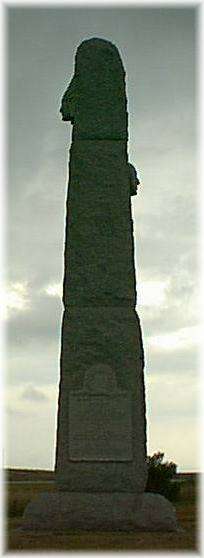Massacre Canyon Battle Monument
category : Monuments
 The Massacre Canyon Battle on August 5th, 1873, was the last battle between the Pawnee Nation and the Sioux Nation. A 35 feet tall - 91 ton pink granite monument boldly stands 3 miles east of Trenton, Nebraska. The face of a Sioux Chief is carved at the top of the monument representing the Sioux as victors of the Battle. The face of a Pawnee chief is carved just below and on the other side of the stone. It depicts one of the worst, and the last, of the many battles between the Sioux and Pawnee Indians. The monument is a memorial of the Frontier Days and the end of the Indian Wars.
The Massacre Canyon Battle on August 5th, 1873, was the last battle between the Pawnee Nation and the Sioux Nation. A 35 feet tall - 91 ton pink granite monument boldly stands 3 miles east of Trenton, Nebraska. The face of a Sioux Chief is carved at the top of the monument representing the Sioux as victors of the Battle. The face of a Pawnee chief is carved just below and on the other side of the stone. It depicts one of the worst, and the last, of the many battles between the Sioux and Pawnee Indians. The monument is a memorial of the Frontier Days and the end of the Indian Wars.Travelers are invited to discover the history of the Massacre Canyon Battle and other Southwest Nebraska attractions at the Visitor's Center located near the monument. The center features stories of early pioneers, information on the tribal customs of the Sioux and the Pawnee People and offers hand crafted Native American gifts and souvenirs.
Visitors are free to enjoy the scenic view of the picnic area while visualizing the climactic battle between two of the last Great Plains tribes. One look into the stone faces carved into the monument makes you stop to wonder what it would have been like to live in the time of the Indian Wars.
Massacre Canyon Battle ....
 During the summer of 1873, chiefs Sky Chief, Sun Chief, and Fighting Bear were peacefully coming up the Republican River on a massive buffalo hunt. More than 300 warriors and 400 women and children were moving into Sioux territory. On August 4, 1873, they reached the north bank of the Republican River and made camp. The Pawnee were warned to be on guard against Sioux attacks. The following morning, they started north up the divide between the Republican and Frenchman rivers.
During the summer of 1873, chiefs Sky Chief, Sun Chief, and Fighting Bear were peacefully coming up the Republican River on a massive buffalo hunt. More than 300 warriors and 400 women and children were moving into Sioux territory. On August 4, 1873, they reached the north bank of the Republican River and made camp. The Pawnee were warned to be on guard against Sioux attacks. The following morning, they started north up the divide between the Republican and Frenchman rivers.Sky Chief, who headed the hunt for his father and was too old to travel, was one of the first Pawnee to die. He had just killed a buffalo and was skinning it when the advance guard of the Sioux shot him. The Pawnee were about 100 yards from the head of the canyon when the Brule and Oglala Sioux War Party led by chiefs Spotted Tail, Little Wound, and Two Strikes were reported coming. The women and children were ordered to take refuge in the canyon with the pack ponies. As the Sioux came over the hill, it was apparent that they outnumbered the fighting men of the Pawnee four to one.
J.W. Williamson, an Indian Scout who had helped to guide the Pawnee on the hunt, raised a white flag and rode toward the Sioux. His horse was shot out from under him.
After the order was given to retreat, the women, children and men dropped their meat and left their pack horses. They mounted their horses and fled down the canyon just east of present Trenton. It was in the retreat down the canyon that the greatest loss of life occurred among the squaws and children as the Sioux rode down each side, firing down on the Pawnee.
After reaching the Republican river, the Pawnee were crossing to the opposite bank when the sound of a bugle stopped them. As a company of U.S. Calvary emerged from the timber, the Sioux turned and fled.
The Pawnee refused to pick up their meat as they believe that it was already poisoned. The Pawnee returned to their reservation north along the Loup and never returned to the traditional Pawnee hunting area along the Republican again.
This battle ended hostilities and opened the land to cattlemen. The first ranches in Nebraska were formed later that year on the open range between Culbertson and Stratton in southwest Nebraska.
Address: 3 miles East of Trenton on Highway 34
Phone: 308-334-5236
Come visit us in Trenton, Nebraska
